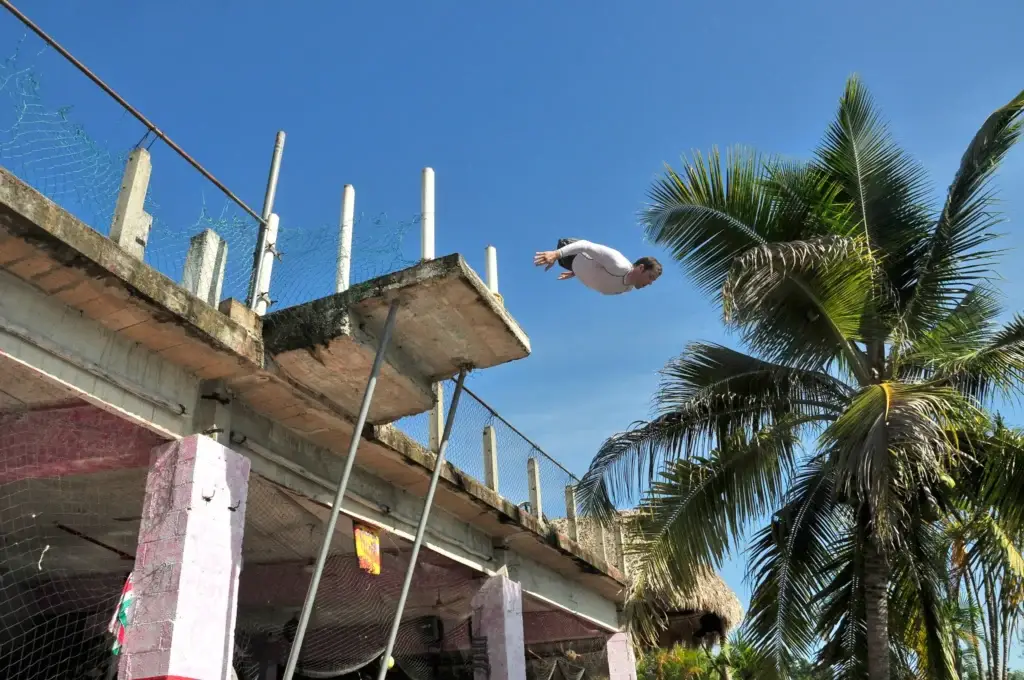
Listen to this Article
Kevin Connolly was born without legs in Helena, Montana. As a kid, he moved best on a skateboard, palms pushing pavement, a handmade leather “butt boot” protecting his hips. It wasn’t polished or high-tech, but it gave him speed, balance, and independence, and it was tough enough to take the scrape of asphalt as he pushed himself across playgrounds, sidewalks, and streets. Unlike prosthetics, which felt clumsy and unnatural, the boot kept him low, steady, and fast, perfectly matched to the skateboard that carried him everywhere.
Travel came early, then study in New Zealand, where life in a big city taught him how relentless curiosity could be. People stared! Wherever he rolled, eyes followed. Curiosity, confusion, sometimes awe. The stares were constant. So, Connolly decided to stare back at them but through a lens. He held a DSLR at hip height, rolled through crowds, and fired bursts without raising the camera.
After taking more than thirty-three thousand photos spanning over 30 countries, he edited the flood down to a hundred striking images. What he captured wasn’t traffic or city noise but the chaos of human reaction to him: faces flashing surprise, confusion, pity, amusement, awe. Children pointing. Adults sneaking glances. Strangers caught mid-gawk or pretending not to look. What once felt like background static in his daily life became the raw material for art, sharpened into a record of how the world looks at difference.
His first exhibition opened quietly at Montana State University, but it didn’t stay small. The work jumped to the Kennedy Center in Washington, D.C., then into his book Double Take with HarperCollins that carried the series worldwide. Suddenly Connolly’s photographs were travelling farther than he ever expected: from New York to New Zealand, 30 countries and counting, forcing audiences to confront the act of looking itself.
The way he travels is inseparable from the way he makes art. Both run on curiosity, light planning, and an openness to whatever comes. Connolly travels with a loose plan. Book the first bed, learn a few greetings, skim local news and pop culture so conversations come easily. Airports can test anyone so he packs light leaving space for things picked up along the way. He carries just a backpack and his skateboard, which weighs about eight pounds, slips through train doors, and repairs easily with standard skate parts. At home in North America, he uses a titanium wheelchair he’s had since 2003. Baggage handlers once dropped it from a plane. It bounced. A drop like that would wreck most chairs, but his was built to last.
He keeps logistics simple. A friend at home holds a small box of spare parts, pre-addressed and postage paid. If a bearing cracks when he’s in Belgrade or a caster splits in Kyoto, one message puts the kit on the next flight. That, he says, is preparation! After that, he lets momentum lead. The goal isn’t checking boxes but making connections.
One of his favorite tricks when in another country is almost absurdly ordinary: get a haircut from a local barber. Barbershops and salons move at neighborhood pace and a trim becomes a window into local life: you sit, listen, trade small talk with staff and clients and breathe in unfamiliar shampoos but it’s worth it. In Zagreb, Croatia, he walked out with a bad haircut but a great memory.
On streets he assumes drivers never see him, and he reads crowds the way a ski racer reads a downhill line. Years in a monoski taught him to map moving bodies, pick the clean path, keep shoulders level and hips steering. He avoids any venue where a wall of people surges in one direction. Liverpool on match day looked promising for photos, then turned into a hazard. Thousands drinking and drifting with zero attention to foot placement is a poor canvas when your hands sit inches above the pavement.
He has never been turned away from a restaurant or gallery for rolling in on a skateboard. If anything, staff nod, smile and keep going. Once in a Kyiv subway a strong, well-meaning stranger bear-hugged him onto a train without asking, a reminder that help works best when offered, not imposed. The single real snag came in Hong Kong, where security seized his skateboard during a transfer; he arrived in Beijing with a loaner chair then reclaimed his board at the gate.
Access varies. Toronto and New Zealand stand out for design and infrastructure. Car-heavy cities often complicate his daily life, while plazas and parks feel safer and more welcoming. But accessibility isn’t just about curbs and ramps, it’s also about people.
Connolly fields questions everywhere. Kids get straight answers at eye level. When adults ask with respect, he takes the time to respond. The repetition can wear him down, but he’s learned that blunt curiosity often opens doors . . to friendships, invitations and unexpected adventures. The trick is not to default to offense. More than once, he’s muttered under his breath, only to watch a supposed gawker cross the street and offer something tender, practical or even brave.
His next project is a book he’s been developing with the working title Low Life. It grew out of the messages he receives from parents and adults with limb differences, practical questions like: How do you sew pants that fit a body like mine? How do you build a butt boot without access to a prosthetics lab? Connolly actually reverse-engineered his own. Leather for the body, durable soling, smart stitching, adjustable fit. Instead of expensive casts and shipping foam moulds across the continent, he uses butcher paper. Sit, trace, take a few measurements and build from there. He patented the design to protect it, then chose a path that keeps the gate wide open.
His book tells the story of making a boot for a boy, weaving in step-by-step instructions and the forgotten history of legless makers who built similar tools again and again, only for the knowledge to vanish. This time, the knowledge will stay.
If he could leave readers with lessons, it would be these:
- Curiosity is universal. It shares sidewalks from Soweto to Shibuya. Let it work for you. Talk, trade tips.
- Pack light. Leave space for what you find on the road.
- Have a backup plan. Keep a repair kit at home, pre-addressed and ready to ship if gear breaks.
- Learn the basics. A few local greetings and snippets of pop culture go a long way in sparking conversations.
- Familiarize yourself with the shows that locals binge. They’re an easy way to start a conversation.
- Get a haircut. Barbershops move at neighborhood pace and deliver better stories than museums.
- Trust your instincts in a crowd. Read movement like a ski slope; avoid surging mobs.
- Choose simple, sturdy gear. If baggage handlers can drop it from a plane and it still works, you chose right.
- Stay curious. Curiosity travels farther than any itinerary.
- Don’t jump to offense. A stare might hide kindness, worry, or an idea worth hearing.
